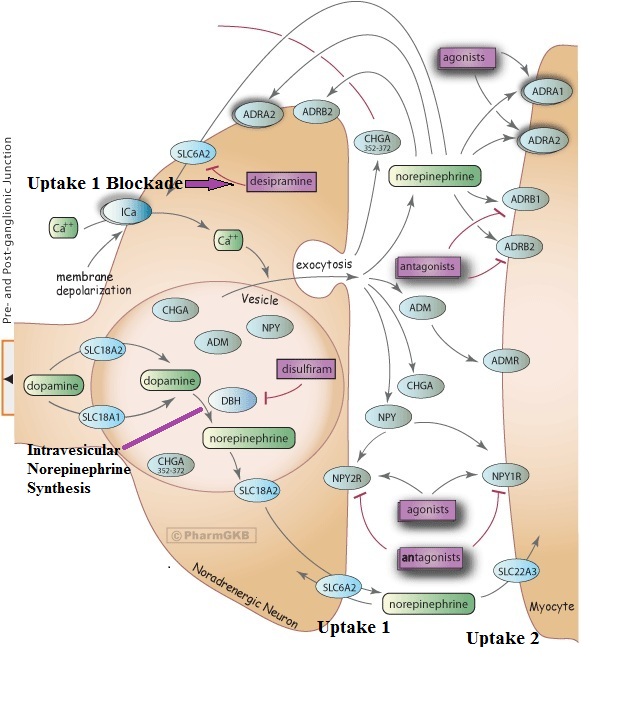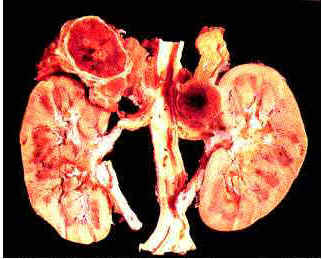|
|
|
Autonomic Pharmacology--Adrenergic Drugs
Review of catecholamine synthesis and release
Norepinephrine is synthesized from the amino acid tyrosine which is translocated by an ATP-dependent transporter into preganglionic sympathetic nerve terminals.10
The rate-determining step (slowest step) in catecholamine biosynthesis is catalyzed by tyrosine hydroxylase which promotes conversion of tyrosine to DOPA (L-3,4-dihydroxyphenylalanine). Tyrosine hydroxylase is subject to product inhibition since elevated concentrations of norepinephrine inhibits enzyme activity; by contrast, reduced levels of norepinephrine promote enzyme activity.10
Tyrosine hydroxylase can be inhibited by an analog to tyrosine, metyrosine.
 |
The activity of tyrosine hydroxylase is also dependent on adequate oxygen supply in that hypoxemic conditions attenuate norepinephrine synthesis.10
Activation of the noradrenergic (neuroeffector) nerve terminal, associated with membrane depolarization (membrane potential sensor: synaptotagmin) , is associated with calcium influx and noradrenergic vesicle fusion with the cell membrane.10
 |
Other substances are co-released with norepinephrine; these include but are not limited to neuropeptide Y and ATP (adenosine triphosphate).
The noradrenergic transmitter release mechanism is brought about by vesicle fusion with the cell membrane; this process is in turn dependent on other proteins including SNAP (soluble NSF, N-ethyl maleimide sensitive factor) attachment proteins and SNARE (soluble NSF receptors).10
Vesicle fusion involves the synaptic vesicular protein synaptobrevin and vesicle-associated membrane protein (VAMP) along with two plasma membrane proteins, syntaxin and SNAP25. SNAP25 is the binding site for botulinum toxin.10
Catecholamine release from noradrenergic terminals and reuptake:
In summary then, presynaptic excitation, i.e. membrane depolarization, can result in norepinephrine release of from noradrenergic terminals.
Stimulation promotes release from a synaptic vesicle storage subpopulation which likely consists of the most recently synthesized norepinephrine molecules.10
These vesicles (about 10%) are described as actively cycling and are contrasted with the larger, reserve population (about 90%). An example, the mixed-acting sympathomimetic drug ephedrine promotes release from this most recently synthesized noradrenergic pool.
Norepinephrine molecule so released may diffuse across the synaptic cleft and interact with postsynaptic adrenergic receptors. Some norepinephrine molecules may diffuse away without interacting and other norepinephrine molecules interact with receptors, then dissociate from those receptors only to bind again at the same or other receptor sites.10
Termination of the action of norepinephrine and postsynaptic receptor sites depends principally on reuptake. [This process is in contrast to what occurs with the cholinergic neurotransmitter acetylcholine whose action is terminated by acetylcholinesterase-catalyzed hydrolysis.]
Most of the released norepinephrine, perhaps about 75%, is taken back up into the presynaptic varicosity which contains storage as well as actively cycling vesicles. The uptake system responsible for this action is termed "uptake-1." 10
A less specific uptake system, "uptake-2" transports norepinephrine into postjunctional tissue sites.10
Another transport system which exhibits high affinity for catecholamines is localized in the noradrenergic vesicle wall. This "vesicular monoamine transporter, VMAT" is inhibited by reserpine.15
Since some norepinephrine molecules may diffuse away from the synaptic cleft and ultimately concentrate in the plasma, these molecules become substrates for metabolism.
Metabolic sites include:10
blood
kidney
liver and
lung (perhaps >25% of norepinephrine may be metabolized in the lung).
As noted earlier, metabolism can involve the mitochondrial enzyme, monoamine oxidase (MAO) and/or cytoplasmic enzyme catechol-O-methyl transferase (COMT). MAO and COMT catalyze biotransformation not only of norepinephrine but also epinephrine and certain other sympathomimetic agents.10
 |
|
 |
|
Catecholamine inactivation as a result of metabolism yields an end product, vanilylmandelic acid which may be detected in the urine.
Elevated levels of this metabolite may suggest the presence of catecholamine-secreting tumors such as pheochromocytoma.10

|

|
||
|
|||
|